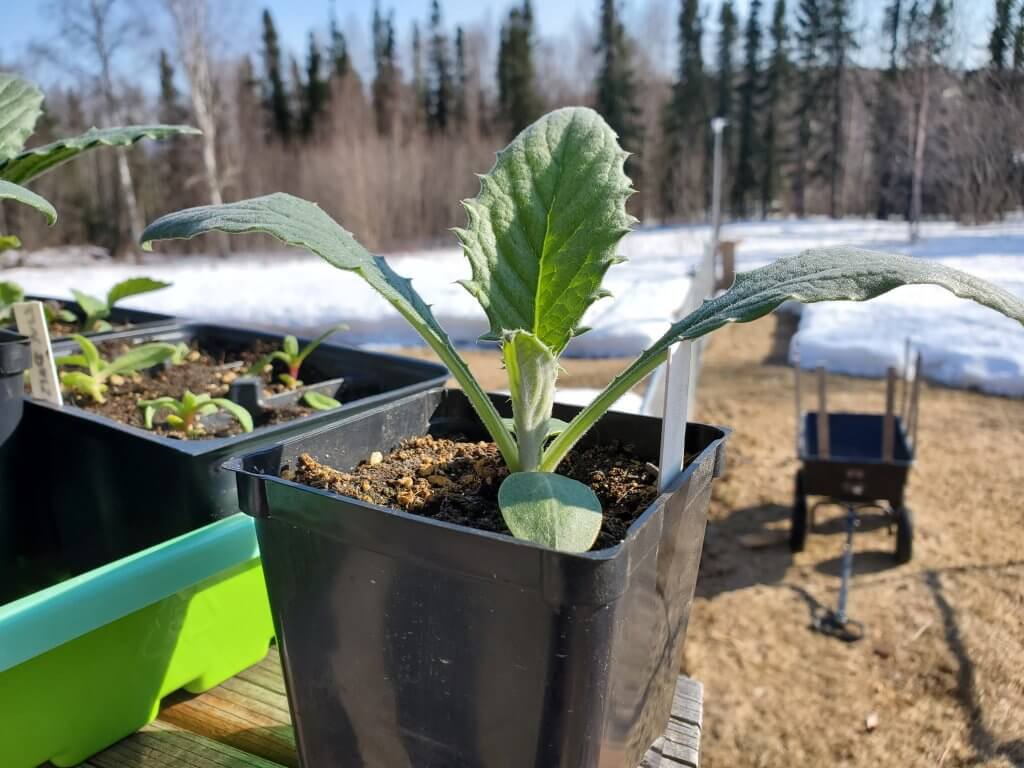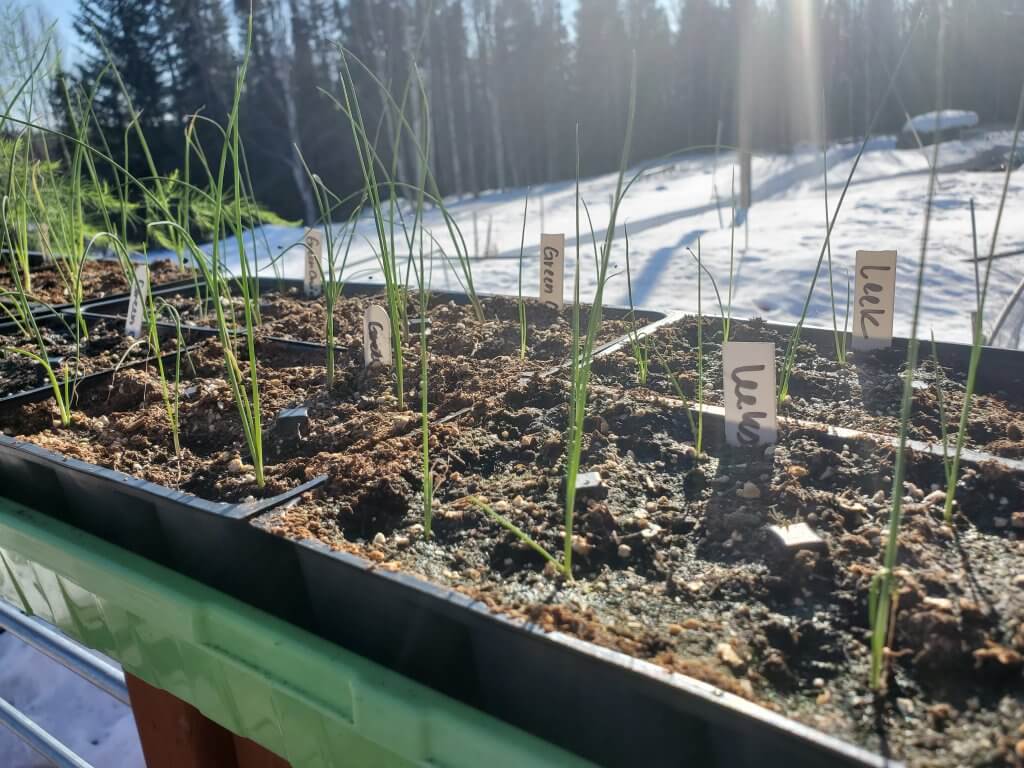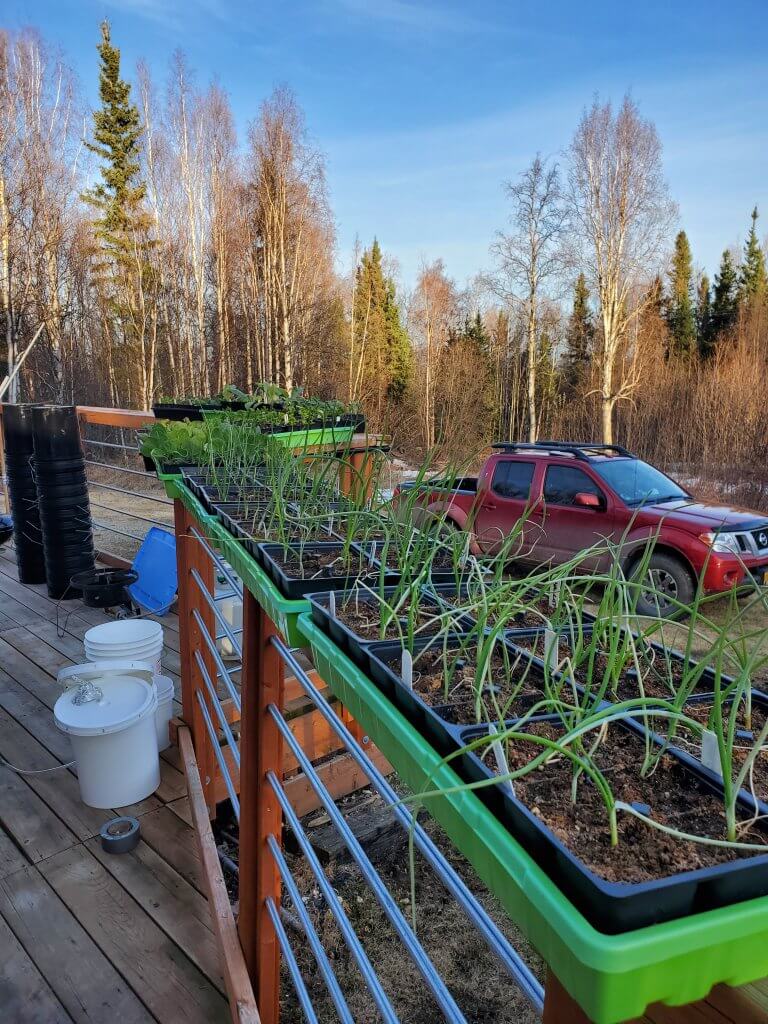In a hurry? If you are here just for our hardening off schedule, click here to skip ahead. Otherwise, read on!
Hardening off your seedlings is a very important step when you raise your own garden starts indoors.
We’ve heard countless tales of gardeners losing their entire crop when they don’t yield this advice. This post aims to tell you all about the subject and also how we harden off our plants!
What Is “Hardening Off” Anyway?
Hardening off is the process of slowly introducing your indoor grown seedlings to the “real” sun. It takes several fairly short exposures for the plant to build up the necessary protections from that bright and powerful source of light!
Essentially, the sun is magnitudes stronger and brighter than any kind of indoor garden lighting you could possibly buy.

The hardening off process typically occurs over several days, for increasingly longer periods of time.
Initially, you want to use really short periods. As the plant becomes accustomed, it can tolerate longer and longer exposures.
In northern climates, we want to use “good, warm days” for hardening off. In general, we recommend daytime temperatures in the 50’s, but you can get away with the mid to high 40’s for most plants.
Hardening off also deals with acclimatizing your plants to outdoor conditions. The process helps prepare them for the “real world” where they must depend on their built-in protection for survival.
Harden Off Plants Off So They Don’t Die
If you don’t harden off your indoor grown seedlings, it is almost a certainty that they will die.
Essentially, the sun will “burn” your plant’s leaves. Not unlike a sunburn on human skin.
Plants can create sort of a natural and permanent sun-tan lotion, if you will. But, it takes a little bit of time to develop these protections.

If a plant hasn’t yet developed the needed protections, the plant’s leaves will usually develop white spots that progress to becoming all white. Once this damage gets severe enough, the plant is no longer able to photosynthesize and will sometimes perish.
There is a fairly short period you have to “rescue” your plants, should you find yourself in a situation with burned leaves. You need to immediately get your plants back into protected, indoor conditions so you have a chance at survival. Nothing is guaranteed, though.
If the hardening off process is simply insufficient, you can still have problems. But, it’s often not lethal to the plant.
Subjecting your plants leaves to sun burn will negatively impact the plant and seriously stunt its growth early on. It can take days to weeks to recover, depending on the plant!
It’s just generally best to avoid problems by using proper hardening off processes.
What? I’ve Never Had To Do This With Store Bought Plants?
In most cases, all nurseries will ensure that plants they sell are properly hardened off, prior to selling them.
Nurseries have all the incentives to make sure plants they sell you will survive. If they didn’t harden off their plants, they would have many unsuspecting, unhappy customers!
Thus, practically all nurseries build hardening off into their processes.

In many cases, these nurseries allow their plants to grow under sunlight for most of their young life. This is an advantage they have with large, heated greenhouses that most of us “common-folk” don’t have. (Or don’t want to afford!)
How Long Does It Take To Harden Off Plants?
The process of hardening off usually takes a minimum of five days.
Some gardeners take a little more time. Few will take less time as there really aren’t great ways to short cut the process.
The days where you harden off your plants don’t necessarily have to be consecutive.
They should be relatively close together, but you can skip a day here or there to account for weather conditions or personal schedules.
When Do You Harden Off Your Plants?
The answer to this question will usually depend on the specific gardener and their specific needs.
For some gardeners, they may want to harden off all of their seed grown plants all at the same time. Typically, these gardeners would harden off shortly before it’s time to transplant into the ground. (Say, about a week before last frost.)

We have a continual hardening off schedule that is based entirely on the temperature tolerance of each type of plant.
Typically, we start the process about six weeks prior to last frost. We start with our cold hardy and frost tolerant plants as we want to get these outside as soon as possible.
As the weather warms up, we continue the hardening off process with frost sensitive plants such as flowers, herbs and others that fall into this category. We typically start hardening off these plants about 3 to 4 weeks before last frost.
For our warm loving plants, we typically wait until 1-2 weeks before last frost. This is highly dependent on weather conditions as these plants really shouldn’t be outside when temperatures are below 50 degrees.
The Truth About Timing For Hardening Off!
We offered you some general timing guidelines above, but there is a bit more nuance to it.
Ultimately, we are looking at the weather. We’re looking for solid days in the 40 degree range. Some seasons simply don’t support an “early” hardening off, whereas some do. The exact timing, for us, is often dependent on the weather.
A big part of it depends on what your goal and gardening capabilities are, though!
For example, if you want to go straight into your garden, timing your hardening off processes would be better aimed around your last frost.
Another example would if you have a greenhouse. If you can heat that greenhouse, you can harden off earlier in the season and allow your plants to live in that heated greenhouse.
If you can’t heat that greenhouse, you really need to wait until low temperatures are consistently warm enough so as to not harm your plants. We provide in-depth guidance on this topic here.
In a particularly warm spring, it’s quite likely we can allow our cold hardy plants to live outside, despite the risks of potential frosts. We watch our weather like a hawk when we are doing this!
Frosty Garden’s Recommended Hardening Off Schedule
We’ve spent a lot of time “playing” with different hardening off schedules. We found a schedule that is as short as it can be, while also being versatile across most plant types.
- Day 1: 45 minutes to 1 hour outside
- Day 2: 2 hours outside
- Day 3: 2 hours outside
- Day 4: 4 hours outside
- Day 5: 8 hours outside
After the above process, the plants can be allowed to live outside for any period of time. They will be sufficiently hardened off at that point.

If you wanted to extend the schedule, we would recommend more time on the shorter periods of being outside. The most useful addition would be another 1 or 2 hour day, for example.
Some gardeners also prefer that the shorter hardening off days be conducted on cloudy days, or under some sort of “diffused” light. We haven’t found this necessary, so long as the first exposures are quite short.
We’ve done it both ways and so long as you’re careful, both ways can work.
We also put together a video on our hardening off processes, in case you learn better that way!
Reading Your Plants For Best Results
While the above schedule has worked incredibly well for us, it’s always important to “read” your plants.
We must teach the plant how to be outside.
If you observe white spots on your plant’s leaves at any point, it means the plant isn’t quite hardy enough.
Just like with humans, a little bit of a sun burn isn’t the end of the world. A big sunburn will be a problem.
When this happens, we often like to give the plants a day off. Or two. We treat them right and give them a little recovery time under “perfect” indoor conditions before we return to hardening them off again.
When you see this, you should probably add at least one more day with less time before moving on to longer schedules. If you’re following the above advice, this usually occurs very early in the process – if it happens at all.
What About “Perfect” Weather Conditions?
A lot of gardeners promote that the first few days of hardening off should be conducted with diffused light of some sort.
Typically, this happens when clouds obstruct the sun to some degree. It can also be artificially created by placing your plants in a somewhat shaded area.
We’ve pretty much found this to be one of those “gardening myths” that really isn’t that important to follow. Is it maybe beneficial? Sure. Necessary? No.

As long as the first day is very short (45 to 60 minutes), we’ve seen very minimal impact on our seedlings even under bright, direct sunlight. The point of our recommended schedule is to allow for three days of relatively short outdoor periods before really starting to push things.
We often don’t have the patience to wait for one of those “perfect” days. We also don’t have shade where we prefer to harden off our garden starts. (Our deck.) We’d rather get the process started, when we want it started.
As mentioned above, we “read” our plants and let them tell us what they need. This is by far more important than any exact schedule or condition.
Thoughts On Subarctic Temperature Hardening
We often encounter a need for acclimatizing some of our plants to cooler weather conditions. This could be a subject on its own, and some day might be.
The gist is that for cold hardy and frost tolerant plants, there is often a benefit to getting these plants outside early in the season. Well before last frost.
Similar to sun hardening, it’s also possible to get your plants used to cooler temperatures. This can allow many types of young seedlings to survive near freezing and sometimes even freezing temperatures.

Using these techniques, we’re able to free up indoor growing space at various periods during the indoor seed starting season. This has allowed us to significantly increase our overall indoor garden start production, without buying more grow lights and other growing space requirements.
It’s important to stress that these kinds of pursuits require close attention to be paid to meteorological conditions. A single night can get away on you and a dip into the teens could spell garden disaster. Beyond that, we’ve also found it beneficial to create sensors and “alarms” for dangerous plant conditions using “smart” technology.
This is a somewhat complicated topic, deeply entrenched in the knowledge of plant temperature tolerance. Most new gardeners should play it safe and not push the limits too much.
40 to 45 degrees is a fine minimum temperature for most garden seedlings. Peppers and other warm loving plants should never experience less than 50 degrees.
That’s All We Wrote!

Having a good time? We have an ever growing list of insightful and helpful subarctic & cold climate gardening articles, waiting out there for you!
- Cold Climate Gardening Basics 👉
- Growing Your Garden From Seed Indoors 👉
- Advanced Cold Climate Gardening Techniques 👉
- Plant Specific Cold Climate Growing Guides 👉
- Subarctic Perennial Food Forests & Foraging 👉
- Indoor Garden Lighting & Grow Rooms 👉
- Greenhouses & Temperature Control 👉
- Harvesting & Food Preservation 👉
- Solving Cold Climate Garden Problems 👉
- 1 Minute Reads On Tons Of Garden Topics 👉
FrostyGarden.com is 100% ad-free and we do not use affiliate links! This resource is voluntarily supported by our readers. (Like YOU!) If we provided you value, would you consider supporting us?
